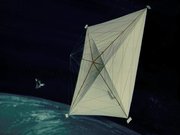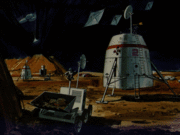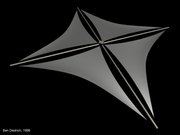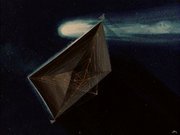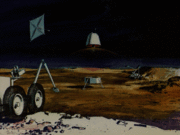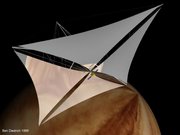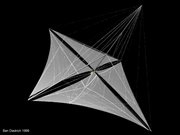Difference between revisions of "Three-Axis Stabilized"
| Line 12: | Line 12: | ||
If booms alone are to support a solar sail, they must act as columns and as beams. As columns, the booms prevent the sail from collapsing inward towards the center. As beams, the booms are stiff and fixed at the center, like a diving board, to prevent the sail from folding up like an umbrella. Here are some examples of solar sails that stabilized in this manner. | If booms alone are to support a solar sail, they must act as columns and as beams. As columns, the booms prevent the sail from collapsing inward towards the center. As beams, the booms are stiff and fixed at the center, like a diving board, to prevent the sail from folding up like an umbrella. Here are some examples of solar sails that stabilized in this manner. | ||
| − | + | [[Image:Square.jpg|thumb|left|A square solar sail that is supported by fixing the booms at the center to support bending and compression as sunlight pushes on the sail. It is very similar to the sail designed by the World Space Foundation for an Earth-Moon race.]] | |
| − | + | [[Image:Cssp.orig.png|thumb|left|Original design by the Canadian Solar Sail Project for a proposed race to the moon in 1992 in honor of the 500 year anniversary of Columbus reaching the Americas. This sail has six sections and steers by tilting the segments of the sail like a Venetian blind to change the direction sunlight pushes on the sail.]] | |
| + | |||
| + | <br style="clear:both;" /> | ||
==Booms, Masts, and Stays== | ==Booms, Masts, and Stays== | ||
| Line 19: | Line 21: | ||
Using a combination of booms, masts, and stays, a 3-axis stabilized solar sail can be made lighter, at the cost of the complexity. By supporting the booms with masts and stays, they only need to act as columns, and not as beams. The masts are set perpendicular to the booms and stays connect between the booms to each other and to the masts. The booms can be made much lighter because the stays and masts prevent the sail from folding up. This kind of structure is similar to a very tall radio antenna that is supported by cables. The following pictures give some example of solar sails with this kind of structure. | Using a combination of booms, masts, and stays, a 3-axis stabilized solar sail can be made lighter, at the cost of the complexity. By supporting the booms with masts and stays, they only need to act as columns, and not as beams. The masts are set perpendicular to the booms and stays connect between the booms to each other and to the masts. The booms can be made much lighter because the stays and masts prevent the sail from folding up. This kind of structure is similar to a very tall radio antenna that is supported by cables. The following pictures give some example of solar sails with this kind of structure. | ||
| − | + | [[Image:Saile01.jpg|thumb|left|The first picture is a square solar sail in Earth orbit similar to a sail the Jet Propulsion Laboratory designed in the late 1970's to rendezvous with Halley's Comet during its last approach. Both solar electric (ion engine) and solar sails were studied intensively for the Halley rendezvous, because these low-thrust propulsion methods were the only way to rendezvous with Halley's Comet in the short time available. Unfortunately, funding was cut for both the solar sail and solar electric studies. This sail uses vanes at each corner of the sail which can be rotated to steer the spacecraft by redirecting sunlight.]] | |
| − | + | [[Image:At_comet.jpg|thumb|left|The second picture depicts another square sail making a rendezvous with a comet. This design has only two vanes at opposite corners, but can still provide full control of the sail.]] | |
| − | + | [[Image:Liftoff.gif|thumb|left|The third picture shows a robotic Mars sample return mission carried by a similar solar sail.]] | |
| − | + | [[Image:Marsland.gif|thumb|left|The fourth picture shows a human Mars mission supported by solar sails. Using a sail similar to that designed for the Halley's Comet mission, a single solar sail could carry a large payload from Earth to Mars in 4 to 6 months every two years. Coming back from Mars, the sail passes through the inner asteroid belt before returning to Earth, where it can fly-by a couple asteroids without losing any time returning to Earth. After a lay-over of about 3 months, the sail could leave for Mars and the asteroid belt again. This short short trip time makes solar sails an excellent option for carrying humans to Mars. This trajectory was developed by Jerome Wright, and is discussed in his book, Space Sailing.]] | |
| + | |||
| + | <br style="clear:both;" /> | ||
| − | + | [[Image:Clipper2.jpg|thumb|left|Front view of Jerome Wright's clipper solar sail design in orbit around Jupiter.]] | |
| + | [[Image:Clipper.jpg|thumb|left|Back view of the clipper solar sail design.]] | ||
Revision as of 10:41, 17 February 2006
Many solar sail designs use a rigid structure, much like a kite, to hold the sail out to catch sunlight. This is called three axis stabilization, because the structure supports the sail in all three dimensions, or axes, without spinning. The three dimensions come from the two dimensions that lie within the surface of the sail, and the third dimension that is perpendicular to the sail.
Attaching the outer edges of the sail to stiff booms that meet at the center of the sail is a good way to prevent collapse in the plane of the sail. The next problem is to prevent these booms from collapsing in the third dimension, like an umbrella being folded. Two common ideas for achieving this are:
- Booms
- Booms, Masts, and Stays
Any other structure that prevents the sail from collapsing, like a stiff outer torus, could work as well.
Booms
If booms alone are to support a solar sail, they must act as columns and as beams. As columns, the booms prevent the sail from collapsing inward towards the center. As beams, the booms are stiff and fixed at the center, like a diving board, to prevent the sail from folding up like an umbrella. Here are some examples of solar sails that stabilized in this manner.

Booms, Masts, and Stays
Using a combination of booms, masts, and stays, a 3-axis stabilized solar sail can be made lighter, at the cost of the complexity. By supporting the booms with masts and stays, they only need to act as columns, and not as beams. The masts are set perpendicular to the booms and stays connect between the booms to each other and to the masts. The booms can be made much lighter because the stays and masts prevent the sail from folding up. This kind of structure is similar to a very tall radio antenna that is supported by cables. The following pictures give some example of solar sails with this kind of structure.
